What I Saw – by Jackie Philpott

Are Catholics Better Sailors?
Earlier this year I was looking through some sailing blog or another when the name of my high school alma mater popped up. What was this? It seems that Mater Dei, a Catholic high school in Southern California, has a sailing team. What? And it is the most competitive sailing team in the state. WHAT?! This astonished me.
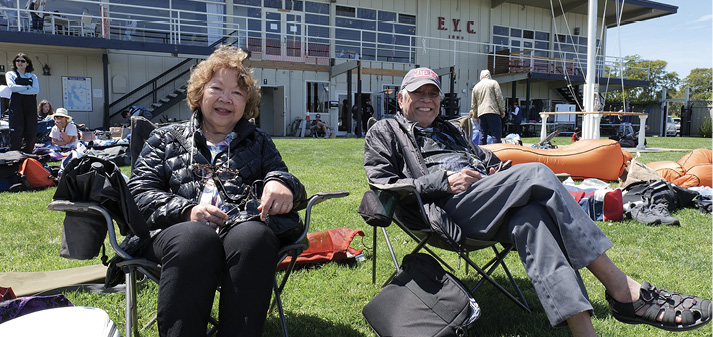
I looked more closely and saw that the Mater Dei sailing team would be participating in a regatta of PCISA, the Pacific Coast Interscholastic Association, at Encinal Yacht Club in Alameda. Of course, I would have to attend.
I decided to drive over and take a looksee, talk with some kids and parents. There were other sailing clubs over there, too, and I’ll talk about them a bit later.
Since Mater Dei did not have a sailing club when I attended, I really had to psychologically catch up. The high school I recalled in Southern California was small, with outdoor picnic tables where we ate lunch. When it rained, and it rarely rained, sitting at one of the inside picnic tables was considered a premium seat. The school was one of several local football favorites back then, and once in a while the team played at the Santa Ana Junior College stadium for games that were bigger draws, but it was not the sports powerhouse that it is today.
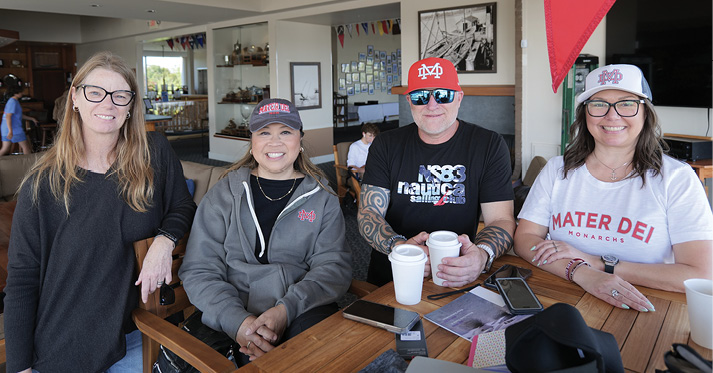
When I first arrived, the parents were already staked out on Encinal’s lawn. Situated just west of the pool, it is at the edge of the Oakland Estuary. The boats du jour were 420s, two-person dinghies that were the one design boat chosen for the day’s competition.
I parked at the same time as Mater Dei parent Laurie Dee and her own parents arrived. As we all approached the entrance to Encinal Yacht Club I introduced myself. Luckily the most recent Bay and Delta Yachtsman Magazine had just been delivered, and it enjoyed pride of place just inside the yacht club’s entrance. An attractive wooden magazine rack held dozens of our glossy magazines, and I waved toward it, hoping it would lend legitimacy. I passed my business cards out like candy.
Laurie and her parents, Jeannette and Manuel Dee, had travelled from Southern California to watch her son, Benjamin Benahmed race. They were all happy to be here in Northern California on a beautiful sunny day sitting in beach chairs in the sun. Laurie was clearly enjoying the day, her family nearby and her son about to participate in a sailing regatta on a beautiful Saturday.
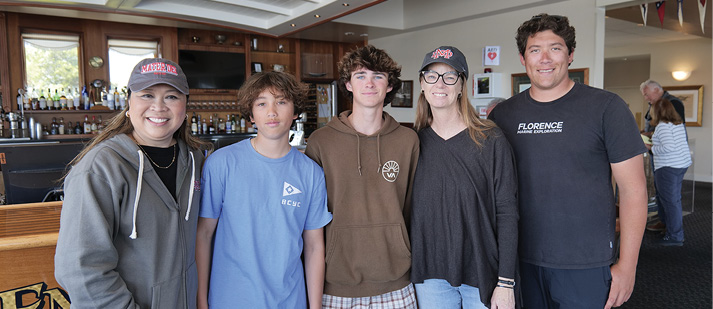
Laurie was very generous and introduced me to other parents, who joined us at a table upstairs when they heard I was interested in their children. Parents love talking about their kids and so we began.
They explained about the huge sports behemoth that is Mater Dei High School, and the connection between Bahia Corinthian Yacht Club and Mater Dei. I was slow to comprehend what they told me: Parents drive from as far away as Beverly Hills so their children can participate in its sports programs. Given the Los Angeles freeway congestion, that is a real time commitment for parents. Children are recruited from yacht clubs as far away as Long Beach to the sailing club.
They are recruited to Mater Dei for the sailing team?! What?
This was baffling to me. When I attended Mater Dei, it was a school for second generation Polish, Italian and Irish kids. There was that rare Catholic from Newport Beach, but for the most part its children were from working class families who lived in places like Garden Grove, Santa Ana and Orange. Were boys recruited for the football team? I doubt it. For the basketball team? I would be very surprised. When I attended Mater Dei my religion teacher was a Capuchin monk. Sister John of the Cross chided us girls in her class for paying more attention to our (forbidden) nail polish than to Edith Hamilton. Sailing would not have been tolerated for those girls. It would have been considered… un-ladylike.
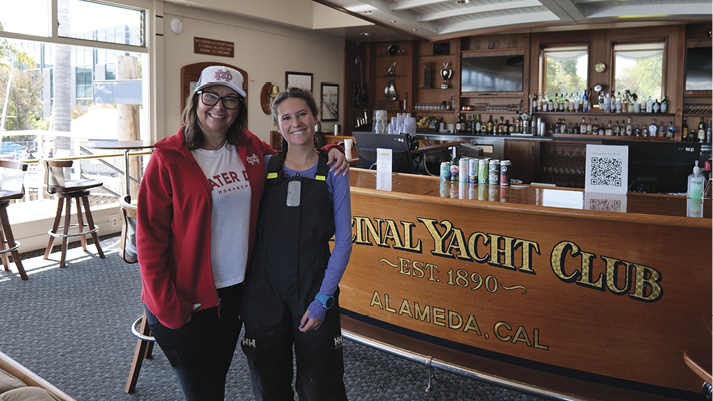
Recruitment to my Catholic high school for the sailing team? This was a brave new world I was learning about here at Encinal Yacht Club. I mentioned my graduation year and Laurie smiled. What a coincidence: That was the year she was born. I winced: Ouch. And yet I soldiered on, a troglodyte among parents.
I learned a lot more from parents Laurie Dee, Farrah Ruddstar and Mark Heineken.
The sports program is so big. Football players come from all around the country. Parents literally move to California so their kid can play on the football team. The football team is #1 in the country for a number of the past years.
Farrah laughed and said, “In Texas they hate Mater Dei! I grew up in Texas so all my friends who played football, when they hear that my daughter is going to Mater Dei? They say “Wow! Your kid goes to Mater Dei? That’s awesome! We hate that football team!”
According to Mark, a prescient alumni member facilitated the initial connection between Mater Dei and the Bahia Corinthian Yacht Club (BCYC), which is located in Corona del Mar. The original architect of the sailing program was Aubrey Mayer, a national champion sailor. After developing the Mater Dei program Coach Mayer moved to British Columbia, where he is currently sailing director at the Royal Vancouver Yacht Club.
Through the creation of a foundation called the Bahia Association of Sailing (or BASRA), BCYC and Mater Dei were able to begin working together to share the cost of the sailing staff and the purchase of boats. That’s how they partially fund the sailing program and give scholarships to help with the sailors’ travel costs to regattas.
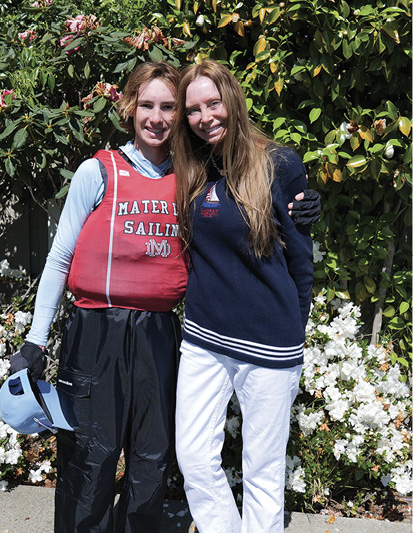
These parents are ambitious for their children in the same way as were the parents of children with whom I went to school. However, tuition is much higher than when I was a child. When I was a child, one of four children, it was impressed upon me that the cost of tuition was a hardship. With these families? I think not so much. Mark Heineken conceded as much when he said, “If they’re being recruited to the sailing team? BASRA will then help with expenses. It’s pretty well organized. The people who are going to go to this school? If you can afford the tuition, you can probably afford the sailing part, too.”
Farrah talked about her daughter, Sophia. Sophia was in 4th grade when Mater Dei started sailing out of Bahia Corinthian Yacht Club. She told her mother “I’m going to Mater Dei.”
Farrah’s response was, “Ok, well let’s see what we have to do to make that happen.”
Then the parents had to go watch their children race, so I walked down to the docks to find someone else to interview.
Encinal Yacht Club Coach Ravecca
During this particular regatta the coaches weren’t allowed to coach from support boats, which meant that all coaches provided last minute reminders to their teams, then stayed ashore. Encinal coach Diego Ravecca sat in the sun at the end of one of the docks, watching his sailors through binoculars. I don’t have a telephoto lens and the sailors were way over on the other side of the estuary, so I sat down on the deck next to Coach Ravecca’s chair in the sunshine and ate my lunch. I asked him about how he happened to become a sailing coach at Encinal Yacht Club. His answer was much more interesting than I expected.
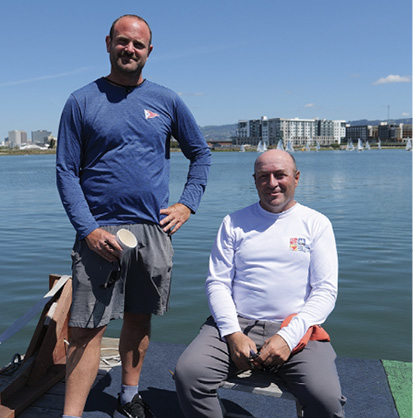
Before coming to Alameda, Mr. Ravecca coached Argentina’s Olympic team. He told me about sailing and coaching in Buenos Aires, where sailing is year-round like in California. There, he said, 100 Optis can be seen on the water on any given day. His youth team qualified for the Tokyo Olympics, and then COVID hit. After that happened, he said, “No more Olympics.” He came to work in the United States. This is the third year during which he has been sponsored by Encinal Yacht Club on what is called a O-1 Visa, which is designated for “individuals with extraordinary ability or achievement.” Indeed.

Coach Ravecca’s wife and two children, ages 6 and 10, remain in Argentina, in La Plata, a town approximately one hour south of Buenos Aires. His son, who is ten years old, has chosen to compete in canoeing at Club Nautico Al Batros, the family’s sailing club. Why did he not choose sailing, I asked. Canoeing offers more group adventures. He shrugs and smiles. Coach Ravecca just wants his son to enjoy being on the water. He is a very gracious man and I enjoyed our brief conversation.
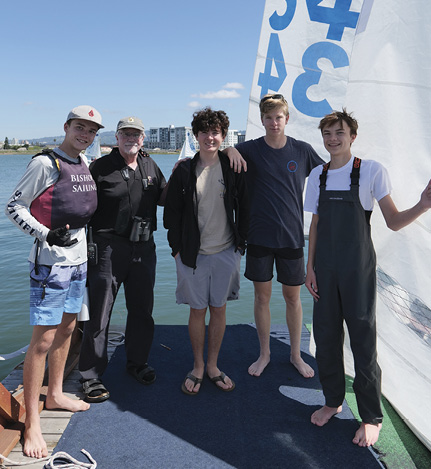
Wandering over to another dock, I had a nice chat with Tony Pelletier, who has been coach of the Bishop’s High School in La Jolla for approximately six years. Coach Pelletier also teaches advanced sciences courses at the school. He owns a pink MC Scout which is a 17-foot flat-bottomed sailboat, the S/V Floyd. Get it?
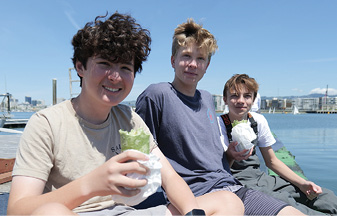
As I walked up the dock toward the clubhouse I passed three young men on the Bishop’s School sailing team. Rowen Harmon was curious and asked, “Don’t you want to take our photo eating Caesar salad wraps?” So, I did, and then I sat down and chatted with Lukas Kapicka, Cameron Rosso and Rowen Harmon as they ate some kind of green burritos. I asked them if the Bishop’s School is affiliated with a particular religion. Lukas and Cameron just shrugged, but Rowen is a live wire. He told me that the Bishop’s School was founded in 1909 and is affiliated with the Episcopal Church. I explained that I had come to interview parents of Mater Dei kids and then we chatted about religion a little bit. They were very engaging but then their burritos were eaten and they went cheerfully to another dock to climb aboard their boats.
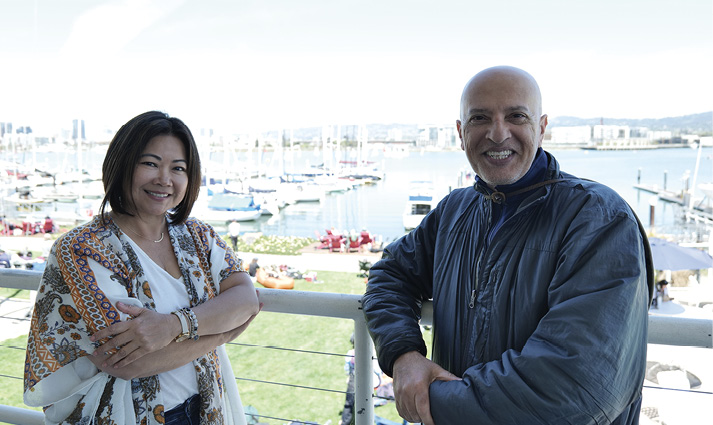
Back up on the upper deck of Encinal Yacht Club I met two parents whose children attend the Bay School, a college prep high school in the Presidio District of San Francisco. Aileen Lagumen’s child is Nolan, and Behn Sarafpour is Kourosh’s father. Kourosh will be taking a two-week sailing class at Richmond Yacht Club this summer, so I might see him again. These parents, they are all committed to their kids.
Oakland Yacht Club
I didn’t really want a hamburger and I sure didn’t want a Caesar salad in a green tortilla, so I left Encinal and walked over to the Oakland Yacht Club to see what was on offer over there. The answer was: Nothing, but I did meet Melissa Sopata in the clubhouse preparing brochures for Opening Day on the Bay. In addition to her role as Oakland Yacht Club’s delegate to the Pacific Inter-Club Yacht Association (PICYA) this is also the second year Melissa has managed registration for the Opening Day on the Bay and its merchandise. She is also keen to publicize a group called Alameda Yacht Club Community (AYCC) and she gave me a brochure describing each club’s attributes. It is described as One Island: eight clubs, representing Alameda Yacht Club, Barbary Coast, Ballena Bay, Aeolian, Island, Encinal and the Single Sailors. All are members of PICYA and the idea, as I understood it, is “a manifestation of community” and an effort to share their unique amenities. They meet once a month to create a sense of community. If you are interested in joining this group, call Oakland Yacht Club @ 510-522-6868 and ask for Melissa.
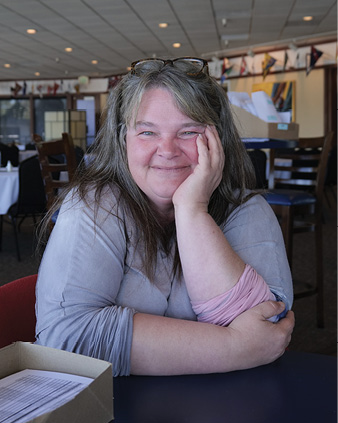
Maritime Business Alert
A year or so ago I interviewed Liz Diaz over at North Beach Marine Canvas, she of the softest and most beauteous of boat cabin cushions and upholstery. Then I interviewed the people over at Spaulding Boat Works regarding their work to restore classic wooden boats. There is a pattern to some of my writing, and that is to collect the oral histories of people who work in the marine businesses of the San Francisco Bay. The businesses are dwindling, people are retiring and words may be the only thing left before we know it. I want to show a little respect.
While I understand that there are canvas shops elsewhere, I write about What I See, which means that the people in my little corner of the sailing world capture my attention. So, here’s a story about Tom, Bill and Deb, three single syllable names that have become synonymous with high-quality, long-lasting canvas creations.
Cover Craft Marine Canvas
There are many satisfied customers who bought dodgers from Tom Krase when he owned Cover Craft. I overheard someone brag about his Cover Craft dodger just the other day. He talked about how Tom’s dodger was made to “the highest standard,” and its remarkable condition after almost 15 years of use. Cover Craft dodgers are considered workhorses, protecting sailors who have travelled all over the world with them.
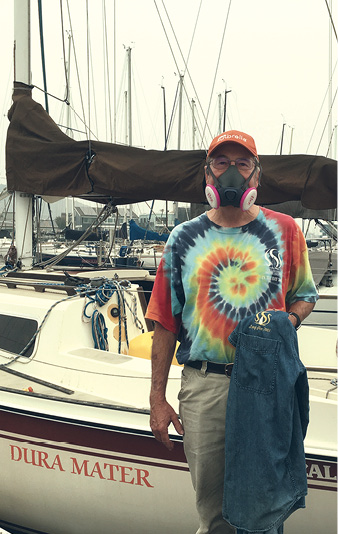
Bill Sistek, who is a dock mate of mine in Richmond, bought Cover Craft in 2020 with his partner Debra Clark. People in-the-know understood that time was running out on the Cover Craft tradition of high quality, and my understanding is that appointments for dodger builds were scheduled many months out. Bill and Deb continued to provide Cover Craft quality craftsmanship until late last year when they both retired.
Bill took the time to email this brief history of Cover Craft. According to Bill, in the early 1980’s Tom Krase was the sail designer at Jim Dewitt’s sail loft. Dan and Pat James from British Columbia, were sailmakers there. Bill joined the loft in 1981, describing himself as “unskilled but enthusiastic.”
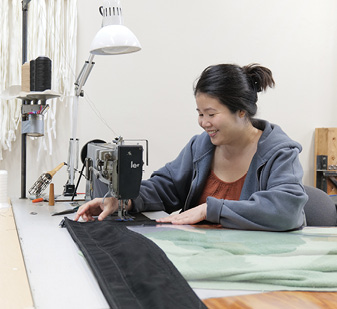
Dan and Pat eventually began doing the canvas work for DeWitt Sails, which was sold to Sobstad Sails in 1983. Sobstad Sails was later sold to Quantum, which is now still located in Point Richmond in Brickyard Cove.
Bill himself left the loft in 1984 to open Windwing Designs with Bill Hansen building high-performance windsurfing sails. Tom Krase left to go cruising aboard S/V Constellation with his family. By the time Tom eventually returned from cruising in about 1995, he decided to open Cover Craft and turned to Dan and Pat for training at their home in British Columbia.
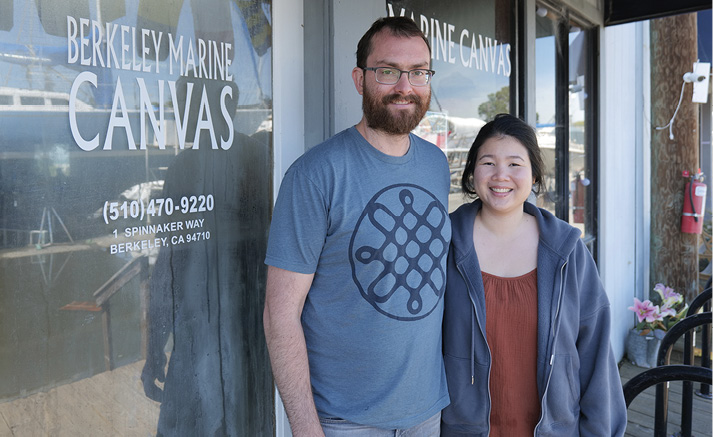
In Jan. of 2020, Bill and Deb took over ownership and operations of Cover Craft. He described his own preparation:
As for my training, it all came from Tom and Deb Clark, working occasionally for Cover Craft over the course of the next 24 years. I spent 2019 working and training full time with Tom and Deb and took over ownership and operations on Jan. 1, 2020.
I am very appreciative to Bill for taking the time to explain the rich tradition of craftsmanship that resulted in the small but influential canvas shop called Cover Craft.
I myself, met Tom Krase back in 2016, when I posted about a windvane on a local sailing blog. He responded and generously invited me to visit his boat in the Richmond Yacht Club harbor to check out his own windvane.
It was a delicate looking thing called a Navik. Attached to the transom of Tom’s 33-foot Wylie, the S/V Constellation, I was skeptical of the Navik’s ability to steer such a heavy-looking wooden boat. However, Tom insisted that he and his wife had found the simple tiller pilot to be remarkably robust, even in difficult sea states around the world. He offered to show me how to set it up if I was able to locate one. When I did, I called Tom up and he met me at my boat. Here is a photo of Tom, who was kind enough to bring not only his own tool bag, but he also wore his vintage Singlehanded Sailing Society t-shirt.
Tom is a generous and knowledgeable sailor. He spent a good deal of time explaining how to set up my Navik, where to screw the tiny little cam cleats onto my tiller, how to balance the paddle and how to adjust it once in motion. Once we had it set up, we motored out of the harbor with the mainsail up. As I turned off the engine he engaged the windvane and… the boat steered without its electric tiller pilot! Tom was so proud of that Navik for its effortlessness. I am grateful to him for his generosity and patience, which is one of the most appealing qualities of the sailing culture in general.
Berkeley Marine Canvas
I met Apo Winprawe on April 15, on her first full day as an American citizen. Apo and her husband, Lowell Harrison, have opened a new canvas shop, located in the Berkeley Marine Center. It is called Berkeley Marine Canvas. Lowell and Apo hope to carry on the tradition of Cover Craft.
Lowell has had a diving business for 10 years and spends a good amount of time underwater cleaning the bottoms of approximately 30 boats on E Dock in the Richmond Yacht Club Harbor.
Apo explained how, in late 2022 she and Lowell returned in October from a trip to find that their boat’s cover had torn apart. It looked like someone had left their boat abandoned and they found it embarrassing. Lowell had a sail rite sewing machine and a roll of Sunbrella, so he built a boat cover in Jeff Wisdom’s office space above the chandlery.
They had one month to make a full boat cover before leaving to visit Apo’s family in Thailand. It was stormy and rainy and Apo described how they both worked down on their hands and knees, pounding grommets into the canvas and cutting with a $5 hot knife that Lowell had purchased on Craigslist.
Lowell reached out to Bill Sistek to ask whether Cover Craft had any work they didn’t want to do so they could start their own business. When Bill told Lowell that he and Deb planned to retire at the end of 2023, they began to talk about buying Cover Craft’s machine and materials. Before they did so, however, they had a series of discussions. Bill and Deb asked to see photos of their work. Apo thinks that Bill and Deb believed in their potential. They offered this advice: Be practical and communicate well and that’s how you build your business.
I asked about the difference between canvas proposals. Lowell’s opinion is that canvas shops all charge within a certain range. There is a low end and a high end and there’s not more than a 10 or 20% difference. But he believes there’s a big quality difference between, for example, what Bill and Deb did at Cover Craft and the work done at some other canvas shops. In Lowell’s opinion Cover Craft made the highest quality dodgers and Biminis.
Lowell: “We want to learn how to make That Dodger, and that will be one big part of our business. We want to be the best dodger company. We have an opportunity to build upon what we are learning from Bill and Deb of Cover Craft. They are teaching us all these proprietary techniques, like how they bend their tubing, how and where material is stretched. We love this idea of carrying on the Cover Craft tradition; of making beautiful, seaworthy and aesthetically pleasing high end dodgers. Premium dodgers. It requires thoughtfulness. Tom and Deb perfected the build of these dodgers for 30 years down to every single detail, down to where you start the stitch at the corner of the plexiglass, whether you glue or tape this strip on. It makes a difference, the kind of tape you use. There are a million things to learn about how to make premium dodgers.
“There’s a particular way to template the curve on a Bimini hoop so that the fabric, when it wraps around that curve, it stays in a tight surface with no wrinkle on the dodger top. Fabric needs to be cut a certain way. When Sunbrella fabric is rolled out, Bill and Deb are teaching us how to cut material this way or this way, depending on how the fabric stretches and shrinks. You can learn to make dodgers from YouTube, but these details and experience, integrating details about how you intend to use your dodger determine minor details of the build.
“We do take a long time right now. We’re very slow. We’ve watched a lot of YouTubes and for now Bill and Deb are always there at the other end of the phone. They have been very generous with their time.”
Apo says: “We are currently repairing a full enclosure made for a powerboat. It was made with polyester thread instead of Gortex thread. Polyester thread only lasts like six years while Gortex thread lasts longer than the fabric itself. We also give customers a care package with instructions about cleaning their dodger. It includes a yearly zipper treatment and there’s a certain kind of soap that you use to wash your dodger window. [Smiles slyly] Or you can buy a dodger cover. That’s called upselling.”
They shook their heads and laughed as they told the story of their first customer. They were living on their 30-foot boat here in the Berkeley Marina. And then? Cree Partridge, owner of Berkeley Marine Center, asked Lowell to do the canvas for his own very high-end racing yacht, S/V Glass Slipper.
Lowell said, “He could’ve gone to any canvas shop, but instead he saw our boat cover and said, “I want that color! I want it to look like that!” That’s how we started this business.”
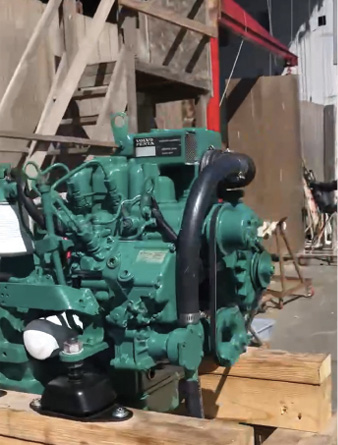
Apo said: “Cree has given us this opportunity, this space to have our canvas shop.”
I left Apo and Lowell then, and went on the hunt for my engine again. While I didn’t find it that day in early April, I do have good news about the new-to-us engine for Dura Mater and me. Just before the deadline for this column I received a video of our rebuilt Volvo 2010. It’s a beauty and I have been promised an install soon. What does this mean? Well, the first thing I’m going to do is make a beeline upriver to Owl Harbor, and then to Mandeville Cut for the Fourth of July. Maybe see you there?
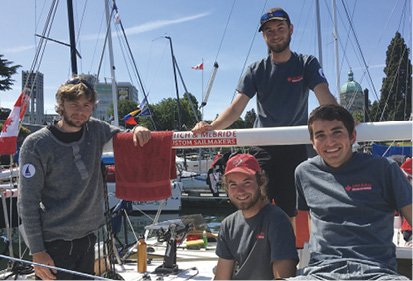
On June 5 I head up to Port Townsend Washington to watch the start of the Race to Alaska (R2AK). I’ll bring back some stories from that wild and crazy race, which I absolutely love for its rule-lessness.
In the meantime, enjoy your time on the water and please write to jackie@yachtsmanmagazine.com to tell me about your own boating experiences. Thank you for reading, and let’s all be careful out there.



